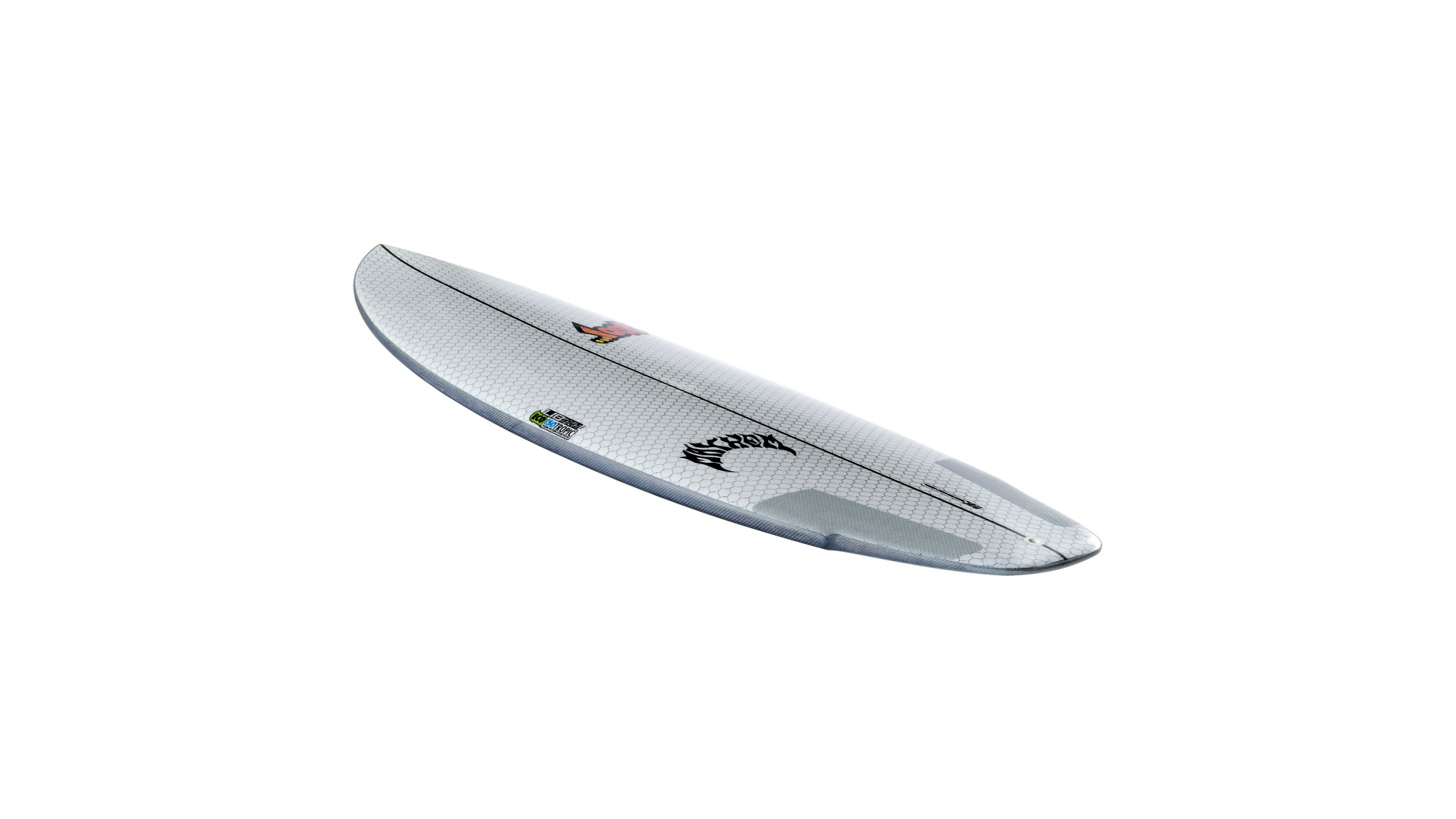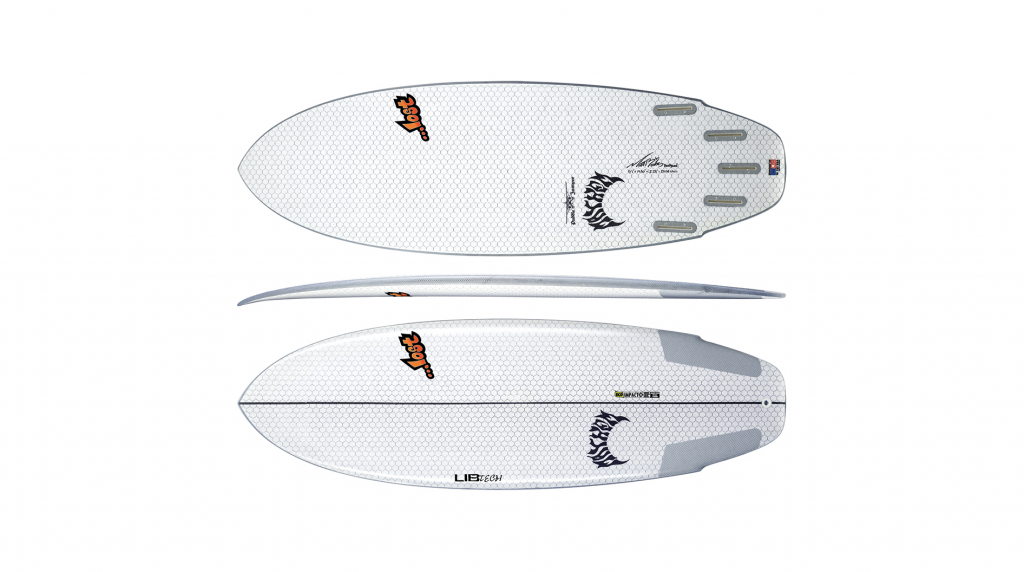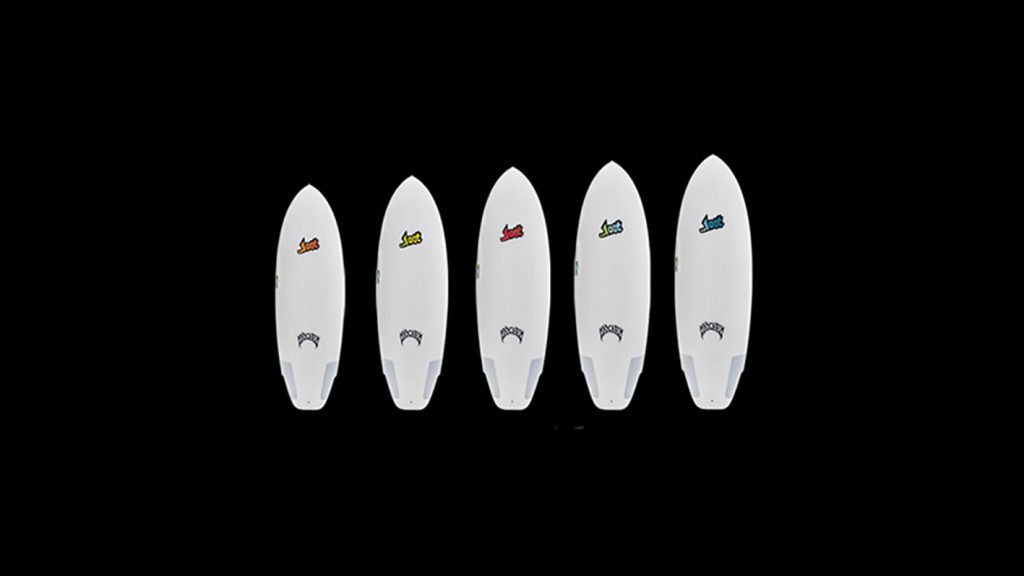How does Lib Tech’s green surfboard build work? And, well, does it work?

Fine-tuned Mayhem Puddle Jumper model in an (almost) indestructible ECO ISO build
It’s not everyday you can buy a new board, throw it down in the surfshop parking lot and then jump on it (bouncing up and down for good measure). The only time I’ve driven over a surfboard was during an inebriated flat spell in Baja (we kept the boards under the truck so they wouldn’t blow away). Now for the clumsy, careless and occasionally intoxicated, Lib Tech has launched one of the world’s strongest surfboards.
Lib Tech partnered with Lost to release several boards over the years including the Puddle Jumper in Lib Tech’s ECO ISO construction. It’s a great fit. Both companies have prospered using the anti-establishment business model as their, um, established business model. Lost Surfboards has also never shied away from new technology as Matt Biolos constantly explores the use of alternative materials, especially in boards designed for wave pools.
“Since I first saw Lib Tech’s ECO ISO construction, I wanted to build a board with it,” said Biolos. “The strength to weight ratio, eco-minded materials and techniques, and the fact that this tech was being built in the USA was incredibly interesting to me.”
Lib Tech’s ECO-ISO construction involves some 30 pieces. To keep it simple we will focus on the basic components of a standard surfboard build: The foam, or core, glass and resin as they pertain to the ECO ISO build.
The foam core is Nitrogencell which is a closed-cell foam (won’t absorb water) with an elongated cell structure which claims to be better for compression strength and energy return. To give the foam additional properties of flex memory and energy return, Lib Tech loads the cells with nitrogen. Nitrogenecell is also made of 25%-50% recycled material – FYI Lib Tech also recycles 100% of the offcuts into new foam.
Hexzylon Fiberfoam surface skin (the chicken-wire looking pattern) goes on where fiberglass would in a standard polyurethane board. “Hexzylon Fibrefoam is a thin outer layer which is comprised of a mixture of very high-density foam and internal fibers shaped into a honeycomb pattern,” says Lib Tech co-founder Mike Olson. “There is a layer of woven basalt fiber fabric bonded directly below the Hexzylon and our proprietary woven magnesium alloy fiber fabric directly above on the board’s surface.” Basalt fiber is placed directly beneath the Hexszylon for more strength.
The silver fabric wrapping the rails is called an Elastomatrix and has metallic fibers. The fabric is said to be stronger, but still flexible enough to dampen chatter in choppy surf.
All these new-to-the-surfboard-world materials are fused using a resin matrix that shares some traits with epoxy, but is very unique (and a trade secret). It includes up to 40% glycerin byproducts from biodiesel processing. And it’s said to be tougher/more durable than conventional epoxy.
The board is finished with micro dimples to decrease friction with the water, similar to dimples on a golf ball. It’s similar to the concept behind Nanotech.
Due to this unique build, Lib Tech recommends not fixing dings but instead using stickers, wax, hot-glue, etc. In the instance, you do need to do ding repair they don’t want you to use PU resin but only epoxy.

The problem the surfboard industry runs into when coming up with lighter, stronger mass building techniques is that the boards rarely capture the subtleties of flex of traditional polyurethane. Although currently epoxy with carbon wrap appears to be the wave pool and surf park construction of choice.
In addition, the shaper’s hard work often gets lost in translation from PU foam to new technology. Biolos says he has done plugs for many manufacturers including BoardWorks (before the move to Thailand), AVISO, Salomon and others.
“These LIB tech first-off prototype boards came back from the factory for approval, dead nuts, closest ever,” says Biolos. “The boards, when cradled in your hand, feel natural like a hand-shaped board – where the shaper labored over getting the bottom rail radius just right. I am not saying we haven’t gotten finished product this refined with other techs, but never so effortlessly.”
The Board We Reviewed: The Puddle Jumper model ridden in this review is a 5’7” x W 21” x 2 1/2 at 33.9 cubic liters. The 195-pound tester’s ability level is average-to-advanced-on-occasion with 35 years of surfing experience. The board we tested weighed 7.1 pounds with traction, wax and fins.
The Puddle Jumper utilizes a concave bottom that transitions to vee in the tail with a wide, straight rail line. The concave bottom is designed to add lift and increased rail curve, which facilitates top-to-bottom surfing while the straight rail line helps the board plane forward.
How did the board surf? Is it really stronger? Can you feel the design subtleties?
We can honestly say the board feels very solid under one’s feet. I don’t know if this is the rocker, bottom contour combination or that I just nailed the sizing on this board. But coming out of turns, late drops, etc. my feet always felt like they were in exactly the right place. From this we gather it’s a very user-friendly design.
We are surprised at how well the board fit in punchy waves. Typically a wide, flat design skips out or pearls in crunchier surf, but the Puddle Jumper was incredibly responsive, so it feels more high-performance than other boards in my quiver of similar design and volume (flatter and fatter). Off the top, it made tight arcs and quick snaps. Even with such a wide tail in the design, the Puddle Jumper did not skip out on snaps and turns. The ECO ISO tech does not feel overly buoyant like so many alternative-constructions can feel (SurfTech, EPS/Epoxy and others).
In totally gutless surf it performed satisfactorily – nothing magical. It has plenty of down-the-line ‘scoot’ but nothing extra special given its size, flat rocker and cubic liters.
We preferred riding it with the thruster set up as that lent the board to more punchy, tight turns. The quad worked well too but lost that magical pivot-point through turns – a standard performance variation when comparing quad to thruster setups. The board still maintained a good down-the-line glide with the thruster setup.

Some More Notes: Flex – It does feel tad feel stiffer than standard PU, but not as stiff and “dead” as some other EPS and alternative-constructions we ride. Also of note, in this short, wide groveler design you aren’t going to notice a board’s flex as much as you would in a high-performance shortboard. The flex of PU boards lose that magic flex after a while, but the ECO ISO build will maintain the same flex pattern for the life of the board. But if I have to say which is more lively between the two, I’d say PU wins.
Strength – Standing on the Lib Tech to avoid hot asphalt during a wetsuit change is pretty cool (same as throwing the board down in the parking lot) because you know you can’t hurt it. One of the most durable boards I’ve seen. Ever.
Fin Boxes – The fins are a bit strange on this design. The boxes are neither FCS nor Futures. They are made to fit both old two-tab FCS fins and Pro Box fins. A plus to this is that you can move the fins forward or back before locking them in with the fin screws. However, there is still a lot of empty space in the fin box. FCS II will not fit the boxes. Some Lib Tech boards now come with Futures boxes. Confusing, but a quick inspection will reveal the type of fin setup.
What We Liked:
-Super strong build
-Doesn’t have that ‘corky’ non-PU feel to it
-Good price point (about the same as a new PU board)
-Surfs very solid underfoot – like a good portion of the board was a sweet spot
-Surfed more high-performance than boards with similar volume and shape
-Stomping on the board in the parking lot and thinking “Wow, I’m not damaging this board”
-Less toxic than standard PU production with lots of recycling done during the board building process
What We didn’t Like
-We would love to see more surfboard models in this technology
-Does not feel quite as springy as a polyurethane-constructed board
-Restriction in fin choice. FCS 2 won’t fit in this style fin box
-The boards hurt more when they hit you in the head. We found this out firsthand. PU boards absorb much of that board-to-head impact in the form of dings.
Green – Of note about Lib Tech’s production model, the ECO ISO construction process is much healthier for the craftsmen building the boards than PU. They also use more environmentally friendly materials and recycle all leftover foam. It’s a big step in the right direction for surfboard manufacturing.
Overall it’s an awesome, tough, fun board that works in a variety of surf conditions. It’s a great option for the rental surfboard agencies who can now offer a high-performance groveller in a super-sturdy technology. The price point is good, especially when you consider that it will outlive by far a standard PU constructed board.
Related Coverage
